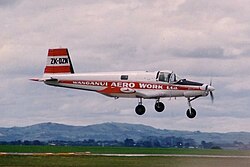Fletcher FU-24
| Fletcher FU-24 | |
|---|---|

|
|
| Type: | Agricultural aircraft |
| Design country: | |
| Manufacturer: | |
| First flight: |
June 14, 1954 |
| Production time: |
1954– |
| Number of pieces: |
309 |
The Fletcher FU-24 (today PAC Fletcher) is an agricultural aircraft from the American manufacturer Fletcher . With the appropriate conversion kits, it is also used as a cargo, passenger and drop-off aircraft.
history
The machine is similar to the Fletcher FD-25 and was designed in 1954 by John Thorpe at Fletcher as an agricultural aircraft for use in New Zealand . The first flight took place on June 14, 1954 and the certification on July 22, 1955. After only eleven pieces of the single-seat FU-24 and six two-seat FU-24A, production was outsourced to New Zealand in 1964, with the machines also being delivered as kits. The production rights were later acquired by various companies, such as Air Parts in 1964, NZ Aerospace in 1972 and Pacific Aerospace from 1982 . Some of the machines were also equipped with Lycoming or Continental engines with an output of 165 to 295 kW. From 1970 on, six prototypes with propeller turbines ( PT6A or TPE 331 ) were also tested, after which many piston engine machines were converted after their successful testing. A modernized version with a Lycoming LTP-101 turbine is produced as PAC Cresco .
variants
- FU-24: Single-seat agricultural aircraft
- FU-24A Utility: Six-seat multipurpose aircraft.
- FU-24-950: Two-seat agricultural aircraft
- FU-24-954: Improved version.
- Pegasus 1: Military version developed by Frontier Aerospace in Long Beach, California
Technical specifications
| Parameter | Data |
|---|---|
| crew | 1 |
| Passengers | until 5 |
| length | 9.70 m |
| span | 12.81 m |
| height | 2.84 m |
| Wing area | 27.3 m² |
| Wing extension | 6.0 |
| payload | 1210 l or 500 kg |
| Empty mass | 1188 kg |
| Max. Takeoff mass | 2465 kg |
| Cruising speed | 210 km / h |
| Top speed | 233 km / h |
| Service ceiling | 4850 m |
| Range | 710 km |
| Engines | an eight-cylinder boxer engine Lycoming IO-720-A1A , 300 kW or PT6A-34AG , 560 kW |
See also
Web links
- Fletcher FU-24 (Phillip Treweek)
- Report on the crash of a FU-24 in New Zealand (Spiegel)
- The Pacific Aerospace Fletcher FU-24 & Cresco
Individual evidence
- ↑ FliegerRevue, September 2010, p. 68, Fletcher FU-24